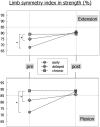Early ACL reconstruction shows an improved recovery of isokinetic thigh muscle strength compared to delayed or chronic cases
- PMID: 37052664
- PMCID: PMC10450006
- DOI: 10.1007/s00402-023-04863-5
Early ACL reconstruction shows an improved recovery of isokinetic thigh muscle strength compared to delayed or chronic cases
Abstract
Introduction: The recovery of periarticular strength is a major criterion in return-to-play testing. The rationale of the study was to assess the impact of the delay of surgery (∆ between injury and surgery) on knee extensor and knee flexor strength of anterior cruciate ligament (ACL)-deficient patients six months after reconstruction.
Materials and methods: In a retrospective cohort study, all patients with ACL ruptures between 03/2015 and 12/2019 were analyzed. Inclusion criteria were isolated ACL rupture without any associated lesions undergoing a reconstruction using ipsilateral hamstring tendon autograft and adherence to isokinetic strength testing before and at 5-7 months postoperatively. These patients were then clustered into three groups: EARLY reconstruction (∆ < 42 days), DELAYED reconstruction (∆42-180d), and CHRONIC (∆ > 180d). Knee extensor and flexor strength of the ipsi- and contralateral leg were analyzed by concentric isokinetic measurement (60°/s). Primary outcomes were the maximal knee extension and flexion torque, hamstrings-to-quadriceps ratio (H/Q) ratio), and the corresponding limb symmetry indices.
Results: n = 444 patients met the inclusion criteria. From EARLY to DELAYED to CHRONIC, a progressive reduction in postoperative strength performance was observed in knee extension (1.65 ± 0.45 to 1.62 ± 0.52 to 1.51 ± 0.5 Nm/kg resp.) and flexion (1.22 ± 0.29 to 1.18 ± 0.3 to 1.13 ± 0.31 Nm/kg resp.) strength on the ACL reconstructed leg. This general loss in periarticular strength was already apparent in the preoperative performance even on the healthy side. When controlling for the preoperative performance using ANCOVA analysis, EARLY performed significantly better than DELAYED (extension p = 0.001, flexion p = .02) and CHRONIC (extension p = 0.005, flexion p < 0.001). Also, there were significantly higher values for H/Q ratio in the injured leg across all groups where the H/Q ratio increased from EARLY to CHRONIC and from pre- to postoperative values.
Conclusions: With respect to the force generating capacity when returning-to-play, it is advantageous to seek for an early ACL reconstruction within the first 12 weeks after the injury. The increasing loss of thigh muscle strength observed in delayed or chronic cases affects the injured and also the non-injured leg.
Level of evidence: III, retrospective cohort study.
Keywords: ACL reconstruction; Isokinetic strength; Return-to-sports; Timing of surgery.
© 2023. The Author(s).
Conflict of interest statement
All authors declare that there is no conflict of interest.
Figures






Similar articles
-
Higher hamstring-to-quadriceps isokinetic strength ratio during the first post-operative months in patients with quadriceps tendon compared to hamstring tendon graft following ACL reconstruction.Knee Surg Sports Traumatol Arthrosc. 2018 Feb;26(2):418-425. doi: 10.1007/s00167-017-4522-x. Epub 2017 Mar 21. Knee Surg Sports Traumatol Arthrosc. 2018. PMID: 28324151
-
Muscle recovery at 1 year after the anterior cruciate ligament reconstruction surgery is associated with preoperative and early postoperative muscular strength of the knee extension.Eur J Orthop Surg Traumatol. 2019 Dec;29(8):1759-1764. doi: 10.1007/s00590-019-02479-3. Epub 2019 Jun 25. Eur J Orthop Surg Traumatol. 2019. PMID: 31240385
-
Knee extensor and flexor strength before and after anterior cruciate ligament reconstruction in a large sample of patients: influence of graft type.Phys Sportsmed. 2019 Feb;47(1):85-90. doi: 10.1080/00913847.2018.1526627. Epub 2018 Sep 29. Phys Sportsmed. 2019. PMID: 30252577
-
No sign of weakness: a systematic review and meta-analysis of hip and calf muscle strength after anterior cruciate ligament injury.Br J Sports Med. 2024 Apr 25;58(9):500-510. doi: 10.1136/bjsports-2023-107536. Br J Sports Med. 2024. PMID: 38537939
-
Restoring Knee Flexor Strength Symmetry Requires 2 Years After ACL Reconstruction, But Does It Matter for Second ACL Injuries? A Systematic Review and Meta-analysis.Sports Med Open. 2024 Jan 5;10(1):2. doi: 10.1186/s40798-023-00666-5. Sports Med Open. 2024. PMID: 38180584 Free PMC article.
Cited by
-
Combining age, sex, body mass index, sport level, and preoperative quadriceps strength improves the predictive ability of quadriceps strength recovery after anterior cruciate ligament reconstruction.Knee Surg Sports Traumatol Arthrosc. 2023 Oct;31(10):4390-4398. doi: 10.1007/s00167-023-07492-y. Epub 2023 Jun 24. Knee Surg Sports Traumatol Arthrosc. 2023. PMID: 37354214 Free PMC article.
-
The optimal window for reconstruction of the anterior cruciate ligament (ACL) with respect to quadriceps atrophies lies within 21 to 100 days.PLoS One. 2024 Feb 1;19(2):e0296943. doi: 10.1371/journal.pone.0296943. eCollection 2024. PLoS One. 2024. PMID: 38300974 Free PMC article.
-
Clinical and radiological outcome of acute quadriceps tendon repair at 2 - year follow-up.Arch Orthop Trauma Surg. 2024 Sep;144(9):4483-4490. doi: 10.1007/s00402-024-05552-7. Epub 2024 Sep 26. Arch Orthop Trauma Surg. 2024. PMID: 39325166
-
Predicting the Recovery of Isokinetic Knee Strength 6 Months After Anterior Cruciate Ligament Reconstruction.Orthop J Sports Med. 2024 Sep 4;12(9):23259671241264845. doi: 10.1177/23259671241264845. eCollection 2024 Sep. Orthop J Sports Med. 2024. PMID: 39247527 Free PMC article.
-
Surgical management of tibial eminence avulsion fractures: a systematic review and meta-analysis.Arch Orthop Trauma Surg. 2024 Jul;144(7):3153-3159. doi: 10.1007/s00402-024-05318-1. Epub 2024 Jun 19. Arch Orthop Trauma Surg. 2024. PMID: 38896276
References
MeSH terms
LinkOut - more resources
Full Text Sources
Research Materials
Miscellaneous

